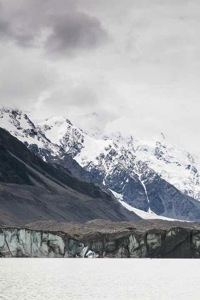[vimeo 119312940 w=480]
This spectacular time-lapse video ((Created by Victoria University of Wellington with the support of Fox Glacier Guides, Department of Conservation, Snowgrass Solutions, University of Canterbury and the Marsden Fund.)) captures the dramatic retreat of the Fox Glacier in Westland over the last year — 300 metres between January 2015 and January this year. As the ice retreats, the hillside becomes unstable and collapses down into the valley. To get a sense of the scale, you can see people watching from a safe point on the bottom right.
The rapid retreat of both Fox and its neighbour Franz Josef has led to the abandonment of guided walks on the glacier tongues. The ice is now only accessible by helicopter on to the upper reaches.
The collapse of the walls of the valley at Fox (as well as rocks and sediment transported by the ice) has caused the valley floor to rise by a metre over the last two years, as measured by Massey University scientists (see also NZ Herald). They’ve also photographed the retreat over the last decade, but the most marked loss seems to be in the last few years.
NZ’s west coast glaciers are amongst the most dynamic in the world, fed by huge snowfalls in their nevées under Mt Cook — as much as 6 metres a year in the snowfield feeding the Franz-Josef, as Mauri Pelto notes here. At the moment, ice melt in the tongues of both glaciers is outpacing the ice input above, and so the glaciers are retreating fast, but a run of years with heavy snowfalls could reverse the process — at least temporarily.

 This article by
This article by 
 This op-ed by climate scientist Jim Salinger first appeared in print editions of the New Zealand Herald last Tuesday.
This op-ed by climate scientist Jim Salinger first appeared in print editions of the New Zealand Herald last Tuesday.
 Further south, the the “root” of the
Further south, the the “root” of the 

